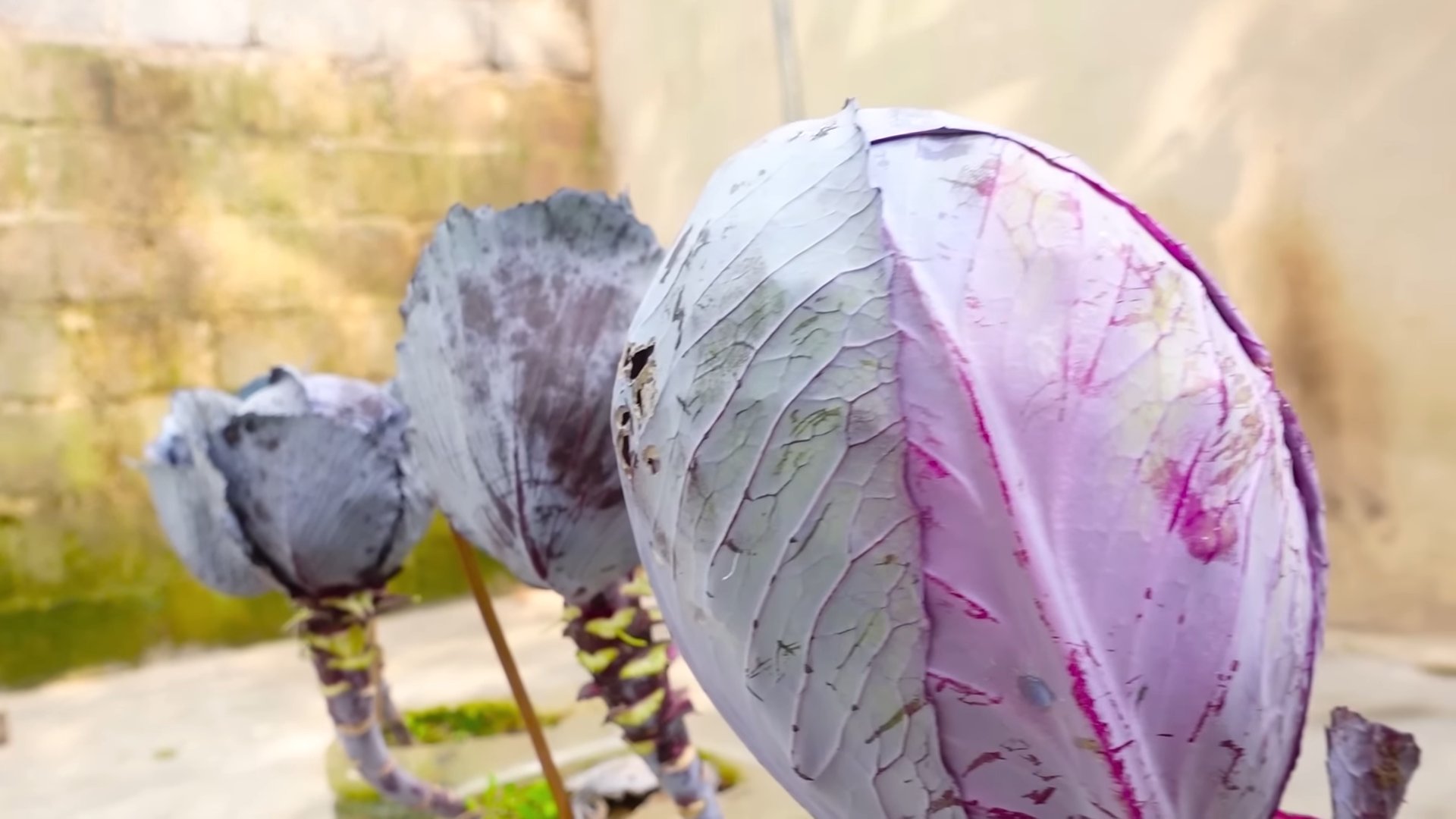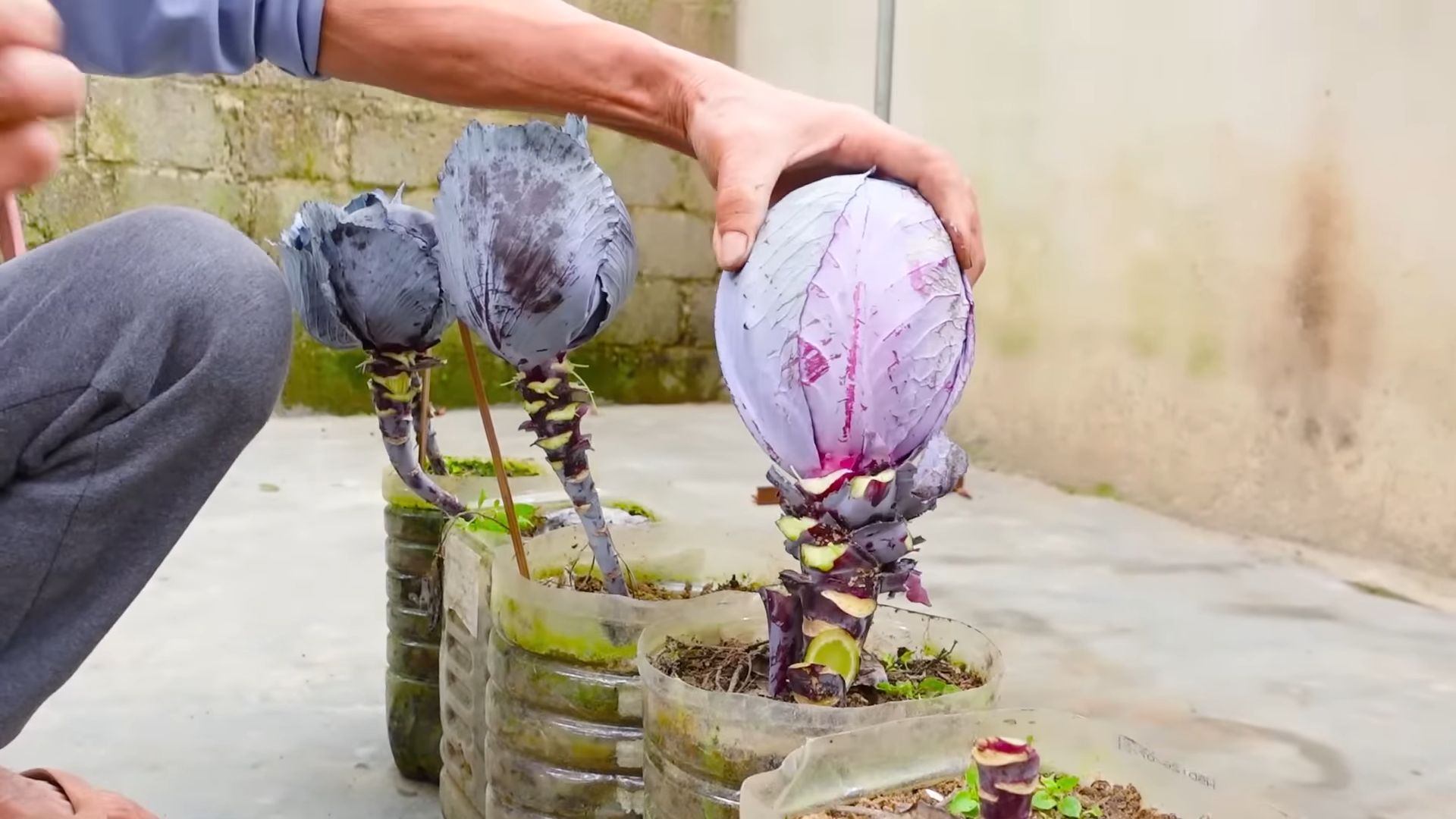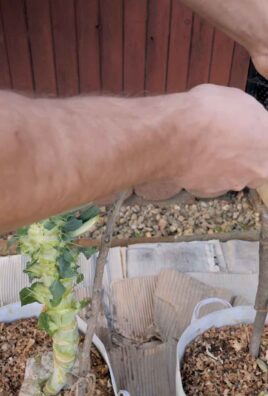Grow Purple Cabbage at Home? Absolutely! Imagine vibrant, jewel-toned purple cabbage heads flourishing in your very own backyard. It’s not just a dream; it’s an achievable reality with a few simple tricks and a little DIY magic. For centuries, cabbage, in its various forms, has been a staple in diets across the globe, from sauerkraut in Germany to kimchi in Korea. But the purple variety? It adds a touch of elegance and a nutritional punch that’s hard to beat.
Let’s be honest, store-bought produce can sometimes be disappointing. Limp leaves, bland flavors – it’s a gamble every time. But when you grow purple cabbage at home, you control the quality, the freshness, and the flavor. Plus, there’s something incredibly satisfying about nurturing a plant from seed to harvest. This DIY guide will walk you through everything you need to know, from selecting the right seeds to protecting your precious cabbages from pests.
Why do you need this DIY trick? Because fresh, homegrown purple cabbage is tastier, healthier, and more rewarding than anything you can buy at the store. Ready to get your hands dirty? Let’s dive in!

Growing Vibrant Purple Cabbage at Home: A DIY Guide
Hey there, fellow gardening enthusiasts! Ever dreamt of adding a splash of color and nutrition to your garden and kitchen? Well, look no further than the magnificent purple cabbage! It’s not just a pretty face; it’s packed with vitamins and antioxidants, and honestly, growing it yourself is incredibly rewarding. I’m going to walk you through everything you need to know to cultivate your own gorgeous purple cabbages right in your backyard (or even in containers!).
Choosing the Right Variety and Starting Seeds
First things first, let’s talk about choosing the right variety. There are several types of purple cabbage, each with its own unique characteristics. Some popular choices include ‘Red Acre’ (a classic, reliable variety), ‘Ruby Perfection’ (known for its deep color and tight heads), and ‘Red Express’ (a faster-maturing option). I personally love ‘Ruby Perfection’ because of its intense color, but feel free to experiment and find what works best for you!
Now, you have two options: you can either start your cabbage from seeds or purchase seedlings from a local nursery. I prefer starting from seeds because it gives me more control over the entire process and it’s generally more cost-effective.
Here’s how to start your purple cabbage seeds:
* Timing is Key: Start your seeds indoors about 6-8 weeks before the last expected frost in your area. This gives them a head start and ensures they’re strong enough to withstand the outdoor elements.
* Seed Starting Mix: Use a high-quality seed starting mix. This is crucial because regular garden soil can be too heavy and compact for delicate seedlings.
* Planting the Seeds: Fill your seed starting trays or pots with the mix and gently sow the seeds about ¼ inch deep. I usually plant 2-3 seeds per cell to increase my chances of germination.
* Watering: Water the soil gently but thoroughly. You want to keep the soil consistently moist, but not waterlogged. A spray bottle works well for this.
* Warmth and Light: Place the trays in a warm location (around 70-75°F) and provide plenty of light. A sunny windowsill might work, but I highly recommend using grow lights for consistent and optimal growth.
* Thinning: Once the seedlings emerge and have a couple of true leaves (the second set of leaves), thin them out, leaving only the strongest seedling in each cell. This gives them enough space to grow and thrive.
Preparing the Garden Bed
While your seedlings are growing indoors, it’s time to prepare the garden bed. Purple cabbage needs well-drained, fertile soil with a slightly acidic pH (around 6.0-6.8).
Here’s what I do to get my garden bed ready:
* Choose a Sunny Spot: Purple cabbage needs at least 6 hours of sunlight per day, so choose a location that gets plenty of sunshine.
* Clear the Area: Remove any weeds, rocks, or debris from the area.
* Amend the Soil: This is the most important step! Amend the soil with plenty of organic matter, such as compost, well-rotted manure, or leaf mold. This will improve drainage, fertility, and water retention. I usually add a generous layer of compost (about 2-3 inches) and work it into the top 6-8 inches of soil.
* Check the pH: Use a soil testing kit to check the pH of your soil. If it’s too alkaline, you can lower it by adding sulfur or peat moss. If it’s too acidic, you can raise it by adding lime.
* Fertilize: Incorporate a slow-release fertilizer into the soil according to the package directions. Look for a fertilizer that’s high in nitrogen, phosphorus, and potassium (NPK).
Transplanting Your Seedlings
Once the danger of frost has passed and your seedlings have developed several sets of true leaves, it’s time to transplant them into the garden.
Here’s how I transplant my purple cabbage seedlings:
1. Harden Off the Seedlings: Before transplanting, you need to harden off the seedlings. This means gradually acclimating them to the outdoor conditions. Start by placing them outside in a sheltered location for a few hours each day, gradually increasing the amount of time they spend outdoors over the course of a week.
2. Choose a Cloudy Day: Transplanting on a cloudy day will help prevent the seedlings from getting stressed by the sun.
3. Dig Holes: Dig holes that are slightly larger than the root balls of the seedlings. Space the holes about 18-24 inches apart. This gives the cabbages enough room to grow and develop.
4. Gently Remove Seedlings: Carefully remove the seedlings from their trays or pots, being careful not to damage the roots.
5. Plant the Seedlings: Place the seedlings in the holes and gently backfill with soil. Make sure the top of the root ball is level with the surrounding soil.
6. Water Thoroughly: Water the seedlings thoroughly after transplanting. This will help settle the soil and encourage root growth.
7. Mulch: Apply a layer of mulch around the plants. Mulch helps retain moisture, suppress weeds, and regulate soil temperature. I like to use straw or wood chips.
Caring for Your Purple Cabbage
Now that your purple cabbages are in the ground, it’s time to provide them with the care they need to thrive.
Here’s what I do to keep my purple cabbages happy and healthy:
* Watering: Water regularly, especially during dry periods. Purple cabbage needs consistent moisture to develop properly. Aim for about 1-1.5 inches of water per week.
* Fertilizing: Side-dress the plants with a nitrogen-rich fertilizer every 3-4 weeks. This will help promote leafy growth and head formation.
* Weeding: Keep the area around the plants free of weeds. Weeds compete with the cabbages for nutrients and water.
* Pest Control: Keep an eye out for pests, such as cabbage worms, aphids, and flea beetles. These pests can damage the leaves and heads of the cabbages. I prefer to use organic pest control methods, such as hand-picking the pests off the plants, using insecticidal soap, or applying Bacillus thuringiensis (Bt).
* Disease Prevention: Purple cabbage can be susceptible to diseases, such as black rot and clubroot. To prevent these diseases, make sure to plant your cabbages in well-drained soil, practice crop rotation, and avoid overhead watering.
Harvesting Your Purple Cabbage
The moment you’ve been waiting for! Purple cabbage is typically ready to harvest about 70-100 days after transplanting, depending on the variety.
Here’s how I harvest my purple cabbage:
1. Check for Firmness: The heads should be firm and dense to the touch.
2. Cut the Head: Use a sharp knife to cut the head from the stem, leaving a few outer leaves attached.
3. Store Properly: Store the harvested cabbage in the refrigerator. It can last for several weeks if stored properly.
Troubleshooting Common Problems
Even with the best care, you might encounter some problems while growing purple cabbage. Here are some common issues and how to address them:
* Cabbage Worms: These green caterpillars can devour the leaves of your cabbage plants. Hand-pick them off the plants or use Bacillus thuringiensis (Bt).
* Aphids: These tiny insects can suck the sap from the leaves, causing them to curl and distort. Spray the plants with insecticidal soap.
* Flea Beetles: These small, jumping beetles can create small holes in the leaves. Cover the plants with row covers or use insecticidal soap.
* Black Rot: This bacterial disease can cause the leaves to turn yellow and black. Plant disease-resistant varieties and practice crop rotation.
* Clubroot: This fungal disease can cause the roots to swell and distort. Amend the soil with lime to raise the pH and practice crop rotation.
Enjoying Your Homegrown Purple Cabbage
Now that you’ve harvested your beautiful purple cabbages, it’s time to enjoy them! Purple cabbage can be used in a variety of dishes, from salads and slaws to stir-fries and soups. I personally love using it in my homemade sauerkraut and kimchi. Its vibrant color and slightly peppery flavor add a unique touch to any meal.
Growing purple cabbage at home is a rewarding experience that allows you to enjoy fresh, healthy, and delicious produce right from your own garden. With a little bit of planning and care, you can easily grow your own vibrant purple cabbages and add a splash of color to your garden and kitchen. Happy gardening!

Conclusion
So, there you have it! Growing your own vibrant, delicious purple cabbage at home is not only achievable, but it’s also incredibly rewarding. Forget relying on grocery store produce that may have traveled miles and lost some of its freshness and nutritional value. With a little patience and these simple steps, you can cultivate your own supply of this nutritional powerhouse, bursting with color and flavor, right in your backyard or even on your balcony.
This DIY trick is a must-try for several compelling reasons. First and foremost, you gain complete control over the growing process. You know exactly what goes into your cabbage – no harmful pesticides or herbicides, just good old-fashioned care and attention. This translates to a healthier, more flavorful vegetable for you and your family. Secondly, growing your own purple cabbage is a fantastic way to connect with nature and learn about the food you eat. It’s a truly satisfying experience to watch a tiny seed transform into a beautiful, edible head of cabbage. Finally, let’s not forget the cost savings! While there’s an initial investment in seeds and perhaps some soil amendments, you’ll quickly recoup that cost by harvesting your own fresh cabbage, especially considering the often higher price point of purple cabbage compared to its green counterpart.
But the beauty of this DIY project lies in its adaptability. Feel free to experiment with different varieties of purple cabbage. Some are more compact and suitable for container gardening, while others produce larger heads perfect for shredding and pickling. You can also adjust the soil pH to influence the intensity of the purple color – more acidic soil tends to result in a deeper, more vibrant hue. Consider companion planting to deter pests and attract beneficial insects. Marigolds, for example, are known to repel cabbage moths, a common nemesis of cabbage growers.
Don’t be afraid to get your hands dirty and embrace the learning process. Gardening is all about experimentation and adapting to your specific environment. Even if you encounter a few challenges along the way, the satisfaction of harvesting your own homegrown purple cabbage will make it all worthwhile.
We strongly encourage you to give this DIY trick a try. It’s a fun, educational, and ultimately delicious way to enhance your culinary repertoire and connect with the natural world. And once you’ve harvested your first head of homegrown purple cabbage, we’d love to hear about your experience! Share your tips, successes, and even your challenges in the comments below. Let’s build a community of home gardeners who are passionate about growing their own food and enjoying the fruits (or rather, vegetables) of their labor. Show us your pictures! Tell us about your favorite recipes using your homegrown purple cabbage. Let’s inspire each other to cultivate a healthier, more sustainable lifestyle, one purple cabbage at a time. Remember, mastering the art of growing **purple cabbage** is a journey, not a destination. Enjoy the process!
Frequently Asked Questions (FAQ)
Q: How long does it take to grow purple cabbage from seed?
A: Generally, it takes about 70 to 90 days from transplanting seedlings to harvest. Starting from seed indoors can add a few weeks to that timeframe. The exact time will depend on the variety of purple cabbage you choose and your local climate conditions. Warmer temperatures can speed up growth, while cooler temperatures may slow it down. Be patient and monitor your plants regularly for signs of maturity. The head should feel firm and dense when gently squeezed.
Q: What are the best conditions for growing purple cabbage?
A: Purple cabbage thrives in full sun, requiring at least 6 hours of direct sunlight per day. The soil should be well-draining and rich in organic matter. A slightly acidic soil pH (around 6.0 to 6.8) is ideal for optimal growth and color development. Consistent watering is crucial, especially during dry periods. Avoid overhead watering, as this can lead to fungal diseases. Instead, water at the base of the plant.
Q: What are some common pests and diseases that affect purple cabbage?
A: Common pests include cabbage worms, cabbage loopers, aphids, and flea beetles. Diseases include black rot, clubroot, and downy mildew. Regularly inspect your plants for signs of infestation or disease. Use organic pest control methods, such as hand-picking pests, using insecticidal soap, or introducing beneficial insects like ladybugs. To prevent diseases, ensure good air circulation, avoid overhead watering, and practice crop rotation.
Q: Can I grow purple cabbage in containers?
A: Yes, you can definitely grow purple cabbage in containers, especially smaller varieties. Choose a container that is at least 12 inches in diameter and 12 inches deep to provide enough room for the roots to develop. Use a high-quality potting mix that is well-draining. Ensure the container has drainage holes to prevent waterlogging. Place the container in a sunny location and water regularly.
Q: How do I know when my purple cabbage is ready to harvest?
A: The best way to determine if your purple cabbage is ready to harvest is to gently squeeze the head. It should feel firm and dense. The size of the head will vary depending on the variety, but generally, a head that is 6 to 8 inches in diameter is ready for harvest. You can also check the color – it should be a deep, vibrant purple. Use a sharp knife to cut the head from the stem, leaving a few outer leaves intact.
Q: How do I store purple cabbage after harvesting?
A: To store purple cabbage, remove any damaged or loose outer leaves. Wrap the head tightly in plastic wrap and store it in the refrigerator crisper drawer. Properly stored, purple cabbage can last for several weeks. You can also shred or chop the cabbage and freeze it for later use. Blanching the cabbage before freezing will help to preserve its color and texture.
Q: Can I eat the outer leaves of purple cabbage?
A: Yes, the outer leaves of purple cabbage are edible, as long as they are not damaged or discolored. They may be a bit tougher than the inner leaves, so you may want to cook them for a longer period of time. They can be used in salads, stir-fries, or soups.
Q: How can I make my purple cabbage more purple?
A: The intensity of the purple color in cabbage is influenced by the soil pH. More acidic soil tends to result in a deeper, more vibrant hue. You can amend your soil with sulfur or peat moss to lower the pH. However, be careful not to make the soil too acidic, as this can inhibit growth.
Q: What are some good companion plants for purple cabbage?
A: Good companion plants for purple cabbage include marigolds, nasturtiums, rosemary, thyme, and dill. Marigolds and nasturtiums help to repel cabbage moths, while rosemary, thyme, and dill can deter other pests. Companion planting can also improve soil health and attract beneficial insects.
Q: What are some delicious ways to use homegrown purple cabbage?
A: The possibilities are endless! Purple cabbage can be used in salads, slaws, stir-fries, soups, stews, and even pickled. It adds a beautiful color and a slightly sweet, peppery flavor to any dish. Try shredding it and adding it to tacos or sandwiches. You can also roast it with other vegetables for a healthy and flavorful side dish. Don’t be afraid to experiment and get creative!




Leave a Comment